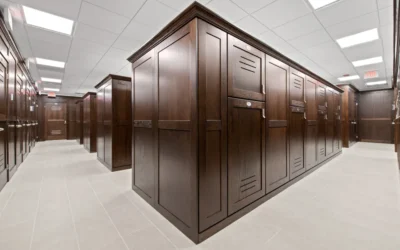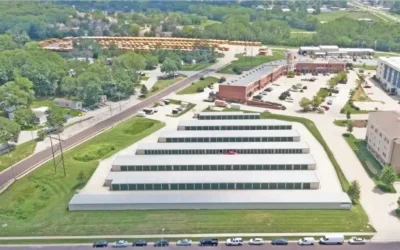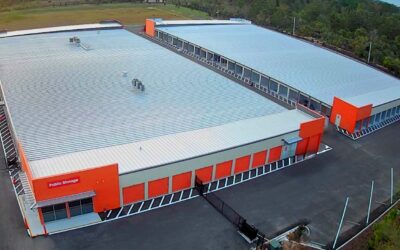It’s not every day you see an oil-drilling company transform itself into a largely self-storage operation.
But that’s exactly what California-based Ojai Oil, Inc. has effectively been doing over recent decades, having founded Golden State Storage in 1974 and grown its portfolio to 20 storage facilities in California and Nevada.
GSS, which next year is celebrating its 50th anniversary in the storage business, plans to expand in coming years, as the OTC-traded Ojai Oil eyes exiting the oil-production business after 113 years in operation.
The storage portfolio features 14 owned or partly owned facilities, and the other six managed by GSS. Two of those 14 owned/partly owned facilities are set to open by the end of this year – one in Las Vegas (715 units) and the other in Santa Fe Springs, Calf. (650 units), the latter at the site of the very first self-storage facility ever built by Golden State Storage.
David Edward, the senior vice president, treasurer, and senior property manager at Ojai Oil, began working at Golden State Storage in 1992, helping to grow the portfolio from seven facilities to today’s 20 owned, part-owned and third-party managed facilities.
A native of England, Edward recently spoke with Spare Foot’s Jay Fitzgerald about Golden State Storage past operations and plans for the future.
Golden State Storage has been around for nearly 50 years and I’m told that you only recently tore down your very first exterior storage facility to make way for a new facility. I understand the old facility was working right up to the end.

Will the building still be profitable as a result of the oil-well complication?
[Laughing] Probably less profitable. Abandoning oil wells can be incredibly difficult. It so happens that in 1941, somebody cut a cable, dumped it down the hole, and we spent months trying to get that 1941 cable out with no success whatsoever. … The city was working with new guidelines. They want wells re-abandoned to a specific way because they don’t want dirty oil migrating through the strata into groundwater. And so they want it all done to a perfect plan. So you start work and then you find this cable 5,000 feet in the ground which you have tried to pick up and you simply can’t get. After a couple of months, you have to say we are not going to get there. So it was a sort of a settlement (with the city) in the end.
GSS currently has 14 facilities that it owns or part owns. Are there plans to increase that number over the next five years or so?
Yes, there are. We purchased a piece of land this year in Oregon, in Redmond, just north of Bend, and we’re planning to develop there. … This is our first venture outside of California and Nevada. We went to Nevada probably 15 years ago.
Any plans to expand into other states beyond Oregon, Nevada and California?
We’re always looking at western states. Something like Ohio or Florida, that’s too far away for us to manage. We like to manage our own properties. So we’ve looked at Arizona and New Mexico in the past. We keep an eye on Utah and Washington. … We have a loose objective of acquiring one property each year and managing a new third party management contract each year. Sometimes you have nothing and then sometimes you have two or three (deals). But that’s the rough numbers we’re looking at. Slow, steady growth.
Do you mostly prefer to develop or do you buy existing facilities?
Well, we’ve done both over the years. We’ve recently migrated into developing because it was hard to compete for good sites with the REITs. Their cost of capital is so much lower. When cap rates came down so low, it’s very hard to compete.
What type of markets do does Golden State Storage like?
Like everybody else, we like to see the high growth neighborhoods with affluent people. But the fact of the matter is we operate in a broad spectrum of markets. We have some small towns, we have inner-city properties. We do have some of those new high growth areas. And we have a range of properties, from brand new Class A to some very old class C’s. We’re used to maintaining and keeping old facilities looking nice while at the same time building new ones.
You’ve been with GSS for years now. What’s the biggest change you’ve seen in the storage industry over those years?
One is the technology. When I first started, everything was in the office and you never had enough (wall sockets) to plug everything in. And now the technology is all in the cloud and there’s so much more of it. And that includes the Internet, which obviously wasn’t around back then. There’s also been tremendous changes in software. … And then we’ve seen consolidation of the industry. It’s still consolidating. There’s much less mom-and-pops and entrepreneurs— and now it’s much more the big boys.
What are some of the biggest challenges facing the industry?
I think one of the challenges is the security of the facilities. Because I think people are starting to break in more and use the spaces incorrectly. We’re also seeing local planning authorities begin to clamp down on storage because they actually don’t want it. The role of the manager is also changing due to automation technology. And another challenge is perhaps a bit more for the tech companies. They struggle with customer support.







